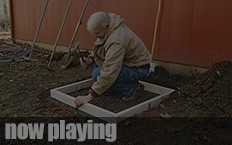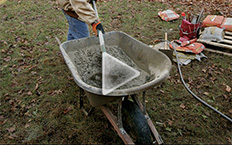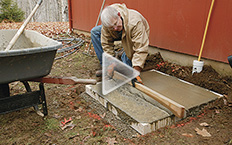How To Build a Form for a Small Concrete Slab
In this 3-part video series, builder Andy Engel demonstrates the basics of forming, mixing, pouring, and finishing concrete projects.
Forming a Small Concrete Slab: Good slabs need good bases. Compacted soil below reduces the odds of settling and cracked concrete. That soil is topped with a layer of gravel that makes setting the forms at the desired pitch a simple matter.
Videos in this series
 |
Part 1: Forming a Small Concrete Slab
Get the base right and the rest is easy |
 |
Part 2: Hand Mixing Concrete
Mixing concrete with a hoe in a wheelbarrow is simple and fast |
 |
Part 3: Placing and Finishing a Small Slab
Tamp down the aggregate in the mix to make a surface that’s easy to finish |
More about building with concrete:
How to Finish a Concrete Patio Slab — Concrete can be finished in one of several ways. Here, Mike Guertin discusses several approaches, including brushing, troweling, and edging.
Reducing the Risk of Cracks in Concrete Slabs — Whether the slab is free-standing or tied into an existing structure, taking a few precautions will help prevent problems later.
Pouring Concrete Slabs — This is how a truckload of wet concrete is transformed into a smooth, flat slab. Less than ideal weather coming up? There are ways to handle that, too.
Fixing Concrete Cracks: Basement Slab Repair — Cracks in concrete basement slabs aren’t uncommon. Matt Risinger explains how to fix cosmetic defects with a two-part filler called RS-88.
Placing a Small Concrete Slab — Although the amount of concrete that’s required is small, a landing for a deck stairway or, in this case, a pad for a propane tank requires nearly the same forming and finishing techniques as a full-size slab






View Comments
By using 2x4 forms you will not get a 4 inch thick slab as stated. Last time I checked a 2x4 will give you a 3.5 inch thick slab. Actually probably less than that since the form will settle into the gravel somewhat.
Why are only the commercials playing and not the videos?
I never sink the nails all the way in when constructing a small cement form because when you try to take the form apart the problems start! Instead, I either use a double headed nail or sink the nails 90% so I can remove the nails with a hammer claw or cats paw tool.